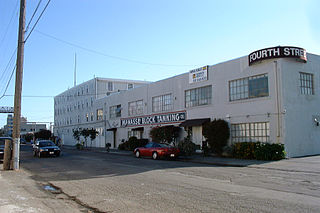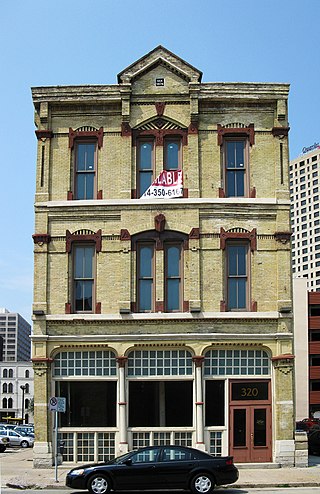Related Research Articles

Leather is a strong, flexible and durable material obtained from the tanning, or chemical treatment, of animal skins and hides to prevent decay. The most common leathers come from cattle, sheep, goats, equine animals, buffalo, pigs and hogs, and aquatic animals such as seals and alligators.

Tanning, or hide tanning, is the process of treating skins and hides of animals to produce leather. A tannery is the place where the skins are processed.

Red Wing Shoes is an American footwear company based in Red Wing, Minnesota that was founded by Charles H. Beckman in 1905.

Ostrich leather is the result of tanning skins taken from African ostriches farmed for their feathers, skin and meat. The leather is distinctive for its pattern of vacant quill follicles, forming bumps ranged across a smooth field in varying densities. It requires an intricate, specialised, and expensive production process making its aesthetic value costly.

Robert Hermann Foerderer was an American businessman and politician who served as a Republican member of the U.S. House of Representatives for Pennsylvania's at-large congressional district from 1901 to 1903 and Pennsylvania's 4th congressional district in 1903.

The Manasse-Block Tanning Company was an American tannery founded in 1900 by August Manasse and Roy Block, whose families had leather-related businesses in Napa and San Francisco, California, respectively. The Manasse-Block tannery was relocated in 1905 from Oakland to 1300 Fourth Street in Berkeley, on a site previously used by the Deach Tannery. Manasse-Block remained in this location for 80 years, until it closed in 1986.

Chromium(III) sulfate usually refers to the inorganic compounds with the formula Cr2(SO4)3.x(H2O), where x can range from 0 to 18. Additionally, ill-defined but commercially important "basic chromium sulfates" are known. These salts are usually either violet or green solids that are soluble in water. It is commonly used in tanning leather.
This article discusses topics related to the environment of Pakistan.

The leather manufacturing process are the operations taken to create leather from hides. The procedure is divided into three sub-processes: preparatory stages, tanning, and crusting. All true leathers will undergo these sub-processes. A further sub-process, surface coating, may be added into the sequence. The list of operations that leathers undergo vary with the type of leather. There are environmental impacts associated with the process.

The Igualada Leather Museum, located in Igualada, Catalonia, was created in 1954 and was the first leather museum in Spain, and the third one in Europe. The collections are displayed in two nearby buildings in Igualada: the "Cal Boyer" building, a former cotton textile factory from the late 19th century, and the "Cal Granotes" building, an 18th-century tannery.

The Tannery is a historic tannery building constructed by the colonial Moravians in Bethlehem, Northampton County, Pennsylvania. It is a limestone building built in 1761, and is part of the Bethlehem Colonial Industrial Quarter.
Humanity has used animal hides since the Paleolithic, for clothing as well as mobile shelters such as tipis and wigwams, and household items. Since ancient times, hides have also been used as a writing medium, in the form of parchment.

The Wisconsin Leather Company Building was built in 1874 in Milwaukee, Wisconsin as the central office and store of one of the first leather companies established in Milwaukee and by the 1870s one of the largest. It was added to the National Register of Historic Places in 2005.
Latigo leather is cowhide leather that is combination tanned. First it is chrome tanned, then it is vegetable tanned. Before modern combination tanning, latigo had been combination tanned with alum and gambier.
Karachi has many environmental issues, severely affecting its biophysical environment as well as human health. The industrialization as well as lax environmental oversight have contributed to the problems. The various forms of pollution have increased as Karachi which has caused widespread environmental and health problems. Air pollution, lack of proper waste management infrastructure and degradation of water bodies are the major environmental issues in Karachi.
The splitting band knife is a kind of knife used in several fields including: tannery, EVA/rubber, foam, cork, shoe and leather goods, paper, carpet and other soft sheet materials. It is a power tool which is very similar in operation to a band saw, with an endless loop blade; the material to be cut is supported by a flat table.
The conservation and restoration of leather objects is the process of determining the causes of deterioration, followed by deciding the best course of action for preserving the leather objects for the future.

Chouara Tannery is one of the three tanneries in the city of Fez, Morocco. It is the largest tannery in the city and one of the oldest. It is located in Fes el Bali, the oldest medina quarter of the city, near the Saffarin Madrasa along the Oued Fes. Since the inception of the city, the tanning industry has been continually operating in the same fashion as it did in the early centuries. Today, the tanning industry in the city is considered one of the main tourist attractions. The tanneries are packed with round stone vessels filled with dye or white liquids for softening the hides. The leather goods produced in the tanneries are exported around the world.

Crocodile skin either refers to the skin of a live crocodile or a leather made from dead crocodile hide. It has multiple applications across the fashion industry such as use for bags, shoes, and upholstery after being farmed and treated in specialist farms and tanneries.

Leather is created when an animal skin or hide is chemically treated in a process called tanning to preserve them for long term use as material for clothing, handbags, footwear, furniture, sports equipment and tools. Alligator leather is also commonly used to create similar items as mentioned above.
References
- ↑ Archived 2011-08-22 at the Wayback Machine 1996 Management of Waste from Animal Product Processing, Section 3: Tanneries
- ↑ 2000 UNIDO The Scope for Decreasing Pollution Load in Leather Processing - Ludvik, Biljan
- ↑ Republican Eagle, First Hundred Years, 41.
- ↑ " Angell, Madeline, Minnesota History, Fall 1981 S.B. Foot Tanning Company Retrieved on January 25, 2010.